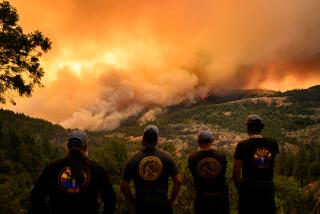Mammoth Lakes Destined for Volcanic Eruption
- Share via
MAMMOTH LAKES, Calif. — The bad news is that a volcanic eruption near this Eastern Sierra town is “certain to occur,” according to scientists who have reported on the results of 17 years of monitoring possible precursors.
The good news, those same scientists say, is that the eruption could be a long time coming and when it happens is likely to be relatively small in size.
Mammoth Lakes is located within the Long Valley volcanic caldera, the site of hundreds of thousands of years of repeated eruptions. The last--a little outside the caldera--occurred about 250 years ago.
“The pattern of volcanic activity over the past 5,000 years suggests that the next eruption . . . will most likely happen somewhere along the Mono-Inyo volcanic chain” west of Mammoth Lakes and extending northward 25 miles to Mono Lake, said a U.S. Geological Survey statement.
“However, the probability of such an eruption occurring in any given year is less than 1%,” reported the five scientists making the statement, which is being widely distributed this month in leaflet form.
A 1% annual likelihood, the scientists explain, “is comparable to the annual chance of a magnitude 8 earthquake along the San Andreas fault in coastal California or of an eruption from one of the more active Cascade Range volcanoes in the Pacific Northwest, such as Mt. Rainier.”
However, they continue, “Depending on the wind direction and the location of an eruption site, future eruptions . . . could spread volcanic ash over the communities of Mammoth Lakes, June Lake or Lee Vining.”
They suggest that the eruption site is unlikely to be on inhabited land, and ash falls on residents may be no greater than the inch that fell on what is now Mammoth Lakes in an eruption 600 years ago.
Intensive monitoring has been ongoing near Mammoth Lakes since 1980, when four earthquakes of at least magnitude 6 struck in a two-day period.
David P. Hill, chief of the monitoring efforts, said this week that one reassuring finding is that the cataclysmic eruptions of the past, such as the collapse of the 10-by-20-mile Long Valley caldera 760,000 years ago, are not a prospect now.
That eruption was 2,000 times greater than the Mt. St. Helens eruption of 1980. Scientists now believe, Hill said, that an eruption near Mammoth Lakes is not likely to approach even Mt. St. Helens in size.
By coincidence, as Hill spoke this week, a swarm of hundreds of tiny earthquakes, too small to be felt, was occurring in an area immediately north and east of Mammoth Lakes. The largest of was in the magnitude 2 range. The swarm continued Thursday.
Scientists affiliated with Duke University who are in Mammoth Lakes this summer joining the Geological Survey in an extensive seismic monitoring experiment said the swarm indicates the movement of small amounts of magma eight or nine miles underneath the surface.
The Geological Survey statement notes that the most recent eruptions along the Mono-Inyo volcanic chain took place about 250 years ago at Paoha Island in Mono Lake.
“When a [new] eruption does break out in the Long Valley area, its impact will depend on the location, size and type of eruption, as well as the wind direction,” the scientists say.
Also, they note, a winter eruption could result in a huge snowmelt, generating destructive mudflows.
*
Most likely, they emphasize, “the next eruption will be small,” similar to what has happened in the last few thousand years.
The next eruption may begin with a series of steam-blast explosions as rising molten rock vaporizes underground water near the Earth’s surface, the scientists say. Those blasts would throw large blocks of rock and smaller fragments hundreds of feet into the air, and leave deep circular pits such as the Inyo Craters.
The scientists add that past eruptions also generated pyroclastic flows up to five miles long, in which superheated ash, rock, air and gases moved at speeds of 100 mph or greater.
“Fortunately, the main population centers in the area are far enough from probable eruption sites that they are unlikely to be directly impacted by future pyroclastic flows,” they said.
Lava flows have been known to occur in the area, the scientists say, “but seldom endanger people because lava flows rarely move faster than a brisk walk.”
More to Read
Sign up for Essential California
The most important California stories and recommendations in your inbox every morning.
You may occasionally receive promotional content from the Los Angeles Times.













